A call has gone out asking for resolution mechanics this January and it feels like a fun exercise. However, the main system projects (as opposed to adventures and other content) I have lined up for this year are a slight tweak on 24XX and using a d20 for FitD-style resolution (similar to Realms of Peril’s approach to PbtA).
Clearly, neither of these are sufficiently new and novel.
So instead, here’s:
1, 2, MAXIMISE

(where possible I aim to make my mechanics sound like rejected Venture Bros episode titles)
Rolling
For any risky action, you always roll two dice. Typically, these are your ability die and your skill die. Certain circumstances may swap one or both of these dice for others such as:
Hireling die
Equipment die
Ally die
Magic die
Diety die
All dice range from d4 to d12.
Roll both dice at the same time. If:
Either die shows a 1, this action has failed
Either die shows a 2, this action has resulted in a mixed success
If both dice show a 3 or higher, this action is a success
If both dice show their maximum values, this action is a critical success
Maximising
Certain character abilities will allow you to maximise a die of a particular size or range of sizes. When you maximise a die:
Set it to its maximum value
Raise the stakes of the roll by accepting a worse consequence from the Referee if you roll a 1 or 2
You may only maximise one die per roll, never both.
As a default, the players as a group are allowed to maximise each die (d4,6,8,10,12) once per session.
Analysis
The odds of fail/mixed/success look like this:
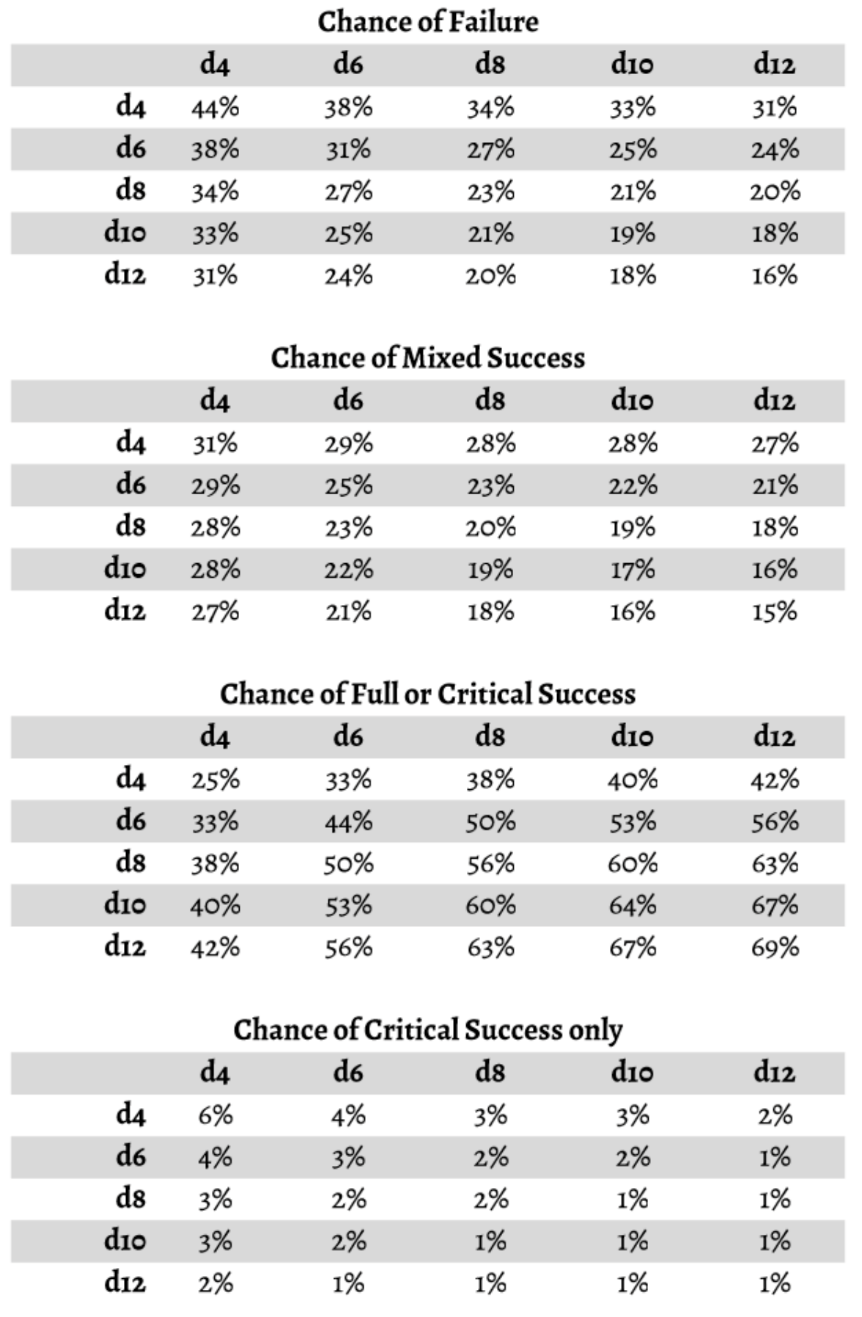
As you can see, the odds of a critical success are extremely low (compared to other systems) once you start rolling anything other than a d6 or d4. Here’s where the MAXIMISING comes in:
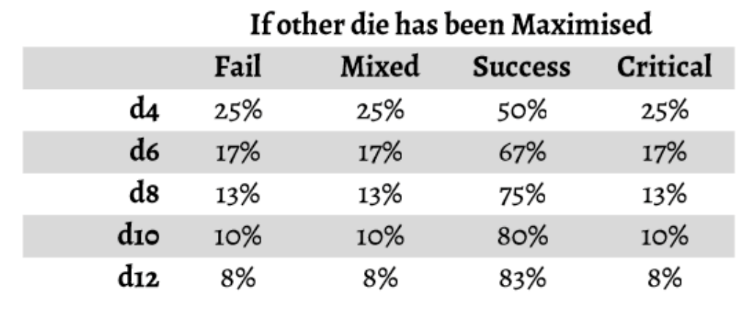
By limiting maximised rolls, and raising the stakes of them, we focus the table’s attention on these rare single die rolls.
What might this be used for?
Despite the mixed successes, I think their lower frequency compared to PbtA/FitD suggests this might be less suitable for a purely narrative game (where you want plenty of them to drive the action). Instead, I think we’re into complex NSR territory — lots of places on the character sheet to pull dice from and potentially have them “break” or become unusable for a time.
But of course, it’s not up to me — go forth and do with this as you will!

Pictured: Crowd chanting “Maximise! Maximise!” at the 2032 live actual play for popular vid-stream ’1, 2, Die!”

Mothership, for all the attention it (rightfully) gets for its layout, strong sense of theme, atmosphere and mass appeal etc, doesn’t seem to elicit much mechanical discussion or hacking. In particular, the Panic Die/Table rules, and the associated trauma responses for each player class.
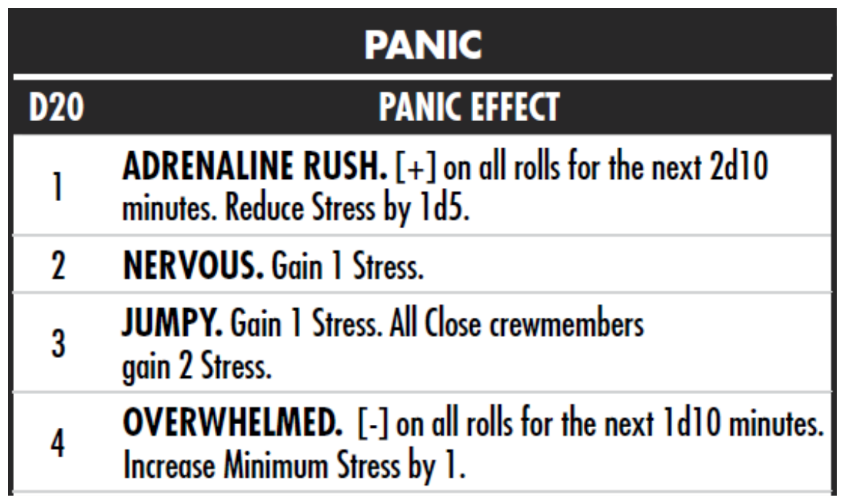

Pondering this has meant I’ve had a draft post entitled “Mothership panic die, but for supply?” sat on my Google drive for a few months. I’m trying to blog more this year, so I decided to actually flesh it out and choose a theme. Thus, I present:
The Panicking Pirate Supply Die
Why Pirates?
I think this mechanic works best for shared, rather than individual
supply. An isolated, irregular assortment of resources also fits the
unpredictable nature of this. A merchant caravan, or a Battlestar
Galactica-style pursuit would also work well.
Note that this deliberately doesn’t mention gold, treasure, booty etc. It is assumed that anything valuable is also functionally useless for survival or that the GM can make rulings if, for example, you need to break open the valuable brandy keg to restore morale.
These rules aren’t intended for any particular system, so feel free to adapt the tags etc as you see fit.
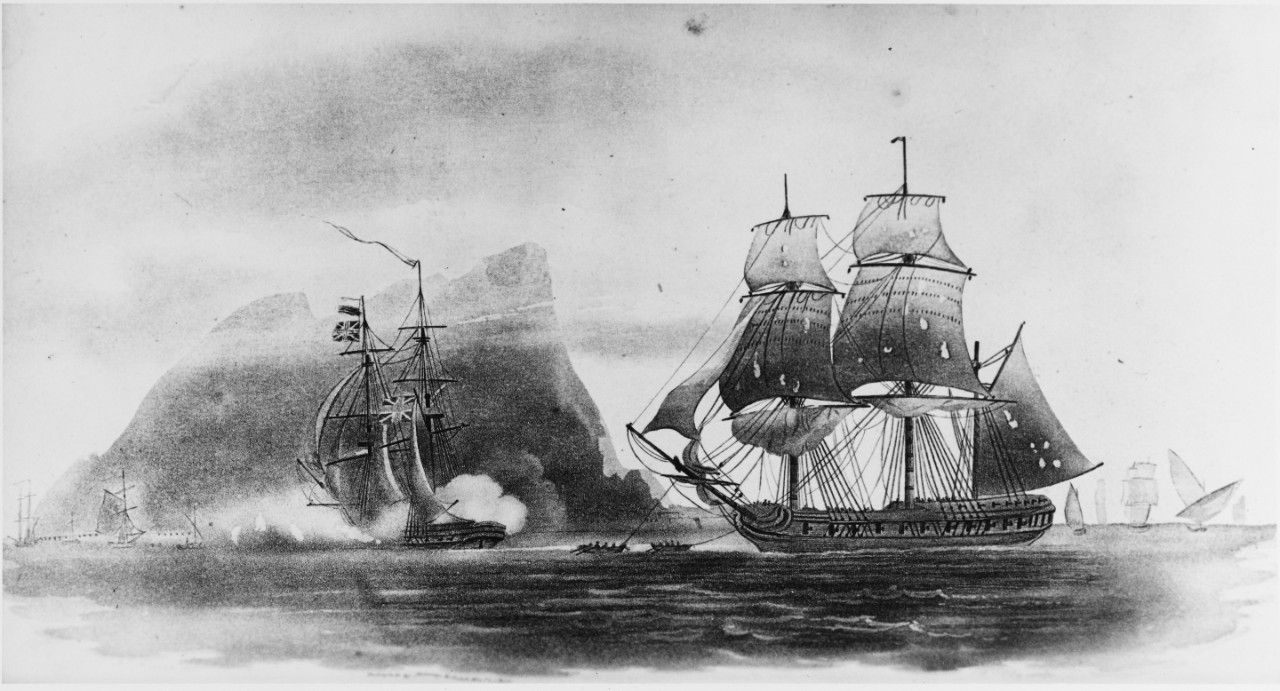
When you start the campaign, each character takes a ship role and chooses a need (see below).
When you begin a voyage, set your supply based on the location you obtained resources from:
20: Large port
18: Small port
16: Captured merchant vessel
14: Uninhabited island
12: Wrecked ship
10: Scavenged flotsam
Reduce supply when you:
Spend a night at sea
Repair damage to the ship
Take on board passengers (or captives, if you treat them well)
Make an Inventory Check:
Every morning at dawn.
When you survive a storm or similar hazard.
When you take back your ship after it has been raided, captured etc
Whenever crew morale becomes critical (this can be triggered by results on the table)
Roll a d20 - if the result is equal to or lower than your current supply, nothing happens. If the result is higher than your current supply, consult the table below:
20. Overlooked cache. Gain 1 supply.
19. Inefficient storage. Lose 1 supply.
18. Missing keepsake. A random crewmember is [Disgruntled].
17. Critical spare part. The ship’s speed, navigation or cargo capability is damaged. This cannot be repaired this voyage.
16. Ink pot overturned. Any logs, maps or charts you make will be short and provide minimum information.
15. Unspiced. D6 crewmembers become [Disgruntled] as the taste of their food can no longer be disguised.
14. Last of the stolen wine. All high status food and drink has been consumed. This may impact diplomacy.
13. Thieving mascot. Lose 1 supply. d6 crewmembers are [Disgruntled]. If you discipline the parrot/monkey/pig/other remove [Disgruntled] from the crewmembers and apply it to a different group of d6 crewmembers instead.
12. Infestation. Spend time and effort to exterminate pests or lose 1d3 supply.
11. Cracked lens. Your telescope’s image is distorted and there is no replacement this voyage.
10. Running dark. You have no more lamp oil or torches this voyage.
9. Hard tack and water. You are down to basic survival rations. 2d6 crewmembers are [Disgruntled].
8. Limeless. The crew become more vulnerable to disease, especially scurvy.
7. Rope, cloth, nails. You can no longer repair the ship beyond minimum functionality.
6. Disorganised. All subsequent inventory checks are made at disadvantage.
5. No medicine, only rum. Halve the rate of any [Healing] onboard ship.
4. Nowt but weevils. The ship has no food remaining. Crew will become [Impaired] tomorrow and perish in 3d6 days (roll separately for each).
3. Out of powder. Each cannon/musket can make one final attack before becoming useless.
2. Rum dry. You have no alcohol left. Entire crew is [Disgruntled].
1. Water, water, every where. No fresh water. Entire crew is [Impaired]. Each crewmember will perish in 1d6 days (roll separately for each).
Ship Roles:
Quartermaster: Gain advantage once per voyage on a single Inventory Check
Bosun: Once per voyage, repair a ship element to full functionality (irrespective of any table results).
Cook: Once per voyage, delay a food-based result on the table for d6 days.
Captain: Suppress [Disgruntled] or [Impaired] on d6 crew per day.
Barber Surgeon: Ignore the effect of a healing or alcohol-based result for a single crewmember once per day.
Needs:
Your character needs one of the following to be fully functional and use all of their skills/abilities:
Alcohol
Fresh food
Healthy crew morale
An undamaged ship
Light
Accurate position/navigation
Medicine
A loaded firearm
Breaking the curse of the Investigation Roll
As someone who is a lore curious, deductive type of player, the phrase “roll investigation on the room” weighs heavily upon me from years playing and running 5e. The following suggestions (especially the rules concept at the end) are not intended to be universal, rather justified for a particular combination of players, setting and campaign premise.
So, there’s been murder. Or a kidnapping. Or a theft. You get the idea.
Most player dice rolls in TTRPGs are either to:
-
Avoid failure (saving throw vs. Death, Into the Odd saves)
-
See what degree of success you achieved (any damage roll, BitD gather information)
-
Both (5e attack roll, PbtA 2d6, Mothership d100 etc)
And a system with decent advice for the referee will add some
variation on:
“Don’t roll unnecessarily, be clear on the stakes of a
roll”
And for the most part, this works really well. Endless perception checks are avoided. Players can collaborate to avoid risky rolls with good planning and clever thinking, whilst maximising their advantages with tasks that can only be resolved by picking up the dice.
But there are a few player actions that stand a little apart, and the one I find my mind drawn to is investigation.
In an ideal world, any kind of investigation roll probably wouldn’t be necessary (and many systems don’t include it). A referee describes a location in flawless detail, and the players respond with logical, plausible actions within this space that perfectly reflect their characters’ knowledge and abilities. All while asking intelligent questions and complementing the referee on their new haircut.
And for many OSR/NSR games, having no specific mechanics works just fine to solve puzzles in dungeons, find secret doors and so forth. Indeed it’s clearer and easier to rule on than the more widely used alternative, the aforementioned 5e Investigation skill:
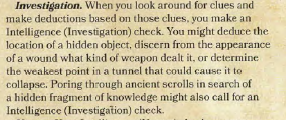
[Excerpt from the 5e Player’s Handbook describing the investigation skill]
However, in my experience the go-to OSR advice of:
“players should describe how they interact with the fictional space
- opening desks, turning over bodies, looking for gaps where something
might be missing”
Becomes less effective when some or all of the following apply:
-
The setting involves a lot of sci-fi tech, magic and/or niche real-world knowledge
-
1 or more players struggle to imagine the world in a way that allows for such specific interaction.
-
The campaign has an investigation/mystery-solving focus (this exacerbates the previous two points).
Game design has already produced a number of solutions to this beyond simply adopting the 5e skill roll model:
-
You can assume that players find a minimum level of information as used in GUMSHOE and its hacks (I do find that this system is slightly misrepresented in posts like this - it’s not quite as straightforward as “hand all the info to the players” - they still need to be in the right place with the right skills to gain additional knowledge).
-
Or perhaps the players make theories, and rolls are to determine their truth as seen in Brindlewood Bay and others.
-
Finally, you can take credit for both rolls and actions - players can choose whether to interact via dice mechanics or description of what their character is doing, with the referee adjudicating accordingly.
[1] is interesting - I think there’s a lot to be learned from the approach, but ultimately I want failure to be an option, just like in the real world.
[3] is my preferred solution. If I run an investigation campaign I want players to feel their characters have distinct abilities far beyond their own (which I find rules out the baseline OSR/NSR approach) but as a referee I enjoy creating a Blorb mystery scenario with landmark, hidden and secret information for my players to unpick. This rules out [2] where the clue placement is entirely different.
But here we run into another couple of problems…
Spam and Failure
Whilst there are many ways to generate time pressure in a mystery scenario (the killer might strike again, you are unofficial investigators and the legitimate ones will be here soon) eventually this strains plausibility. In such a scenario some players (and I have occasionally had to stop myself from this) will go at a fictional space like they’re in Extreme Makeover: Home Edition. No stone will be left unturned or indeed checked to see whether it’s a fake stone, a magic stone and what happens if you throw the stone out the window.
Regardless of whether you’re using the stone turner skill or describing your lifting and turning in great detail - you’re spamming. There is no in-game consequence to failure to find information, so the referee has to step in at some point and say “you’ve learned everything you can here, please leave the victim’s relatives to their grief”.
But to defend the players in this scenario - they are well aware that failure is an option. If they keep looking in the wrong place, and not finding anything, then there’s an out of game consequence - and it’s that the game grinds to a halt! So they’re highly motivated to search for everything.
How do we solve both these problems?
You can, of course, build on the time pressure element and widen it
to include all sorts of complications. The aforementioned Brindlewood
Bay does this in classic PbtA fashion by allowing the Keeper to make all
sorts of moves on a player failure using the Meddle Move.
Cthulhu Dark also has a neat solution to spamming - the more you roll
the more likely you are to “see too much of the Mythos” with all the
consequences that implies. Brute forcing your way through that game at
the cost of your sanity is practically encouraged. That seems very
specifically Lovecraftian but you could run a dark, real-world game that
way - perhaps where it represents the stress of the job. However, that
might not be all that much fun. What we’re trying to evoke here is the
trope of the world-weary detectives and private eyes in a city of crime
more than career burnout and obsession. There are the easy solves, the
day-to-day simple motivations… and then there’s the cold cases, the
baffling murders.
Firstly, I would always frame this sort of campaign as one with multiple ongoing mysteries at once and almost certainly run a percentage of them like GUMSHOE scenarios - you’ll always find something, it won’t be too difficult to put the clues together.
This means that failure is an option. And that events can take their course in the fiction to keep a particular case open (the thief strikes again and steals something even stranger/more valuable). This isn’t a novel solution - for example almost 5 years ago to the day, Sean McCoy proposed it (along with an interesting idea of structuring deduction for the players).
But we also need something that encourages players to consider ending
their time at the crime scene early - something that makes “we’ve got
enough to work with” the cue for the next scene more than “we have wrung
every possible piece of information from this place and its
inhabitants”.
And as a bonus, ending scenes earlier saves time at the table (always at
a premium).
A Mechanical Proposal
The Insight Pool
The players have a shared pool of insight, represented by tokens. When the players take on a case add insight to the pool (1 insight per player).
Players add insight when they deliberately make their investigation more obvious, personal or otherwise complicated. Examples:
-
You ransack the room as you search it, even though this will make it obvious that you’ve been here.
-
You know someone with specialist knowledge - but they are an academic rival who despises you.
-
You realise the victim pulled you out of a bar fight years ago, time to repay an old debt.
1 Insight can be spent to ask the GM “is there information we missed that would be helpful here?” If the GM cannot offer anything useful, your Insight is not spent and is instead returned to the pool.
(Note: I suspect Insight can be used to boost skill rolls or equivalent as well, representing the additional motivation of the complications pushing the players to dramatic success. Plus it prevents a pool of tokens hanging around uselessly when you already know whodunnit but you need to act on the information and bring them to justice or the nearest equivalent).
The Pressure Pool
The referee adds to the pressure pool when the players exhaust a line of inquiry or otherwise fail to learn new information - be that from skill rolls or simply from interacting with the fictional space.
(Note: Failures from non-investigative skill rolls do not add to the pool - they have their own consequences.)
The GM can spend:
2 pressure: remove 1 insight or amplify an obstacle
(see examples below)
-
The Chief is on your back about questioning the Mayor’s Son - leave the kid alone or your ass is on the line
-
Even though you know he didn’t do it, the person arrested for the crime starts bragging for the notoriety - and the citizens want a swift hanging
-
Venris the Bloody is tired of your words and turning over of stones. A trial by ordeal shall settle this matter in front of the Gods.
Two metacurrencies!? In this economy!? My original thinking was to do Pressure with a Blades in the Dark style clock (or the Brindlewood Keeper moves mentioned earlier), but I think tokens give the referee more flexibility to choose when they deploy them, whilst the 2:1 exchange means players can’t ever be sure they’ll have all their Insight to spend (and encourages them to keep the pool low).
The intention is to make players hold off on scrutinising every detail and generate those “information flashbacks” that are so common in the third act of crime dramas. Note that it still has to be information that the players could have encountered - we assume a failed roll in the past means they glossed over a detail that now becomes relevant. And it’s a shared pool since it should be a group decision to ask for a hint.
The “amplify an obstacle” phrasing also ties into the Blorb principle. Rather than “introduce a new twist/plot element” we build on the established setting - it could even be specifically detailed in advance as part of the Referee’s prep. The additional entanglements and complications are then shifted more onto the players - either to gain insight or as specific consequences for non-investigation rolls.
So there you have it - in the New Year I’ll be attaching this to a basic skill engine (perhaps 24XX) and sending players on some low fantasy mysteries. I’m thinking “Inverted Lies of Locke Lamora” - a group of truth seekers and vigilantes working in a loose hierarchy to determine what justice looks like for them and the people the so-called “law” of the city doesn’t care about.
A Player-Facing Sandbox Part 1 - The Map
I had intended for a while to write a fairly dry, mechnical post about the gameplay implications of travel distance and hence on map building, but then a couple of things happened:
- I read Prismatic Wasteland’s excellent hexcrawl checklist (Part 1 and Part 2)
- I watched Map Crow’s video, which packs a lot of good map design (including some valuable points from open world videogames) into just 15 minutes.
And I thought “well, there’s probably enough theory out there… but perhaps I can create an example of how I build something”.
But this post is also meant to show how I iterate between mechanics and fiction. In my opinion each drives the other, and it’s by considering both that we achieve ludonarrative harmony, rather than dissonance.
Some Assumptions
We aren’t going to be building for a particular system here, but we should at least set our baseline mechanics and fiction. Let’s assume we’ve had our Session 0 or equivalent, and agreed that:
- We want to play a hexcrawl - players are expecting isolated settlements, overland travel and emergent gameplay.
- The players are going to be given a map of the area, along with some rumours and other general information.
- We’re using Gold-as-XP AND/OR that accumulating treasure is the default motivation of our PCs. Much of the advice below works without this, but remember this is baseline.
- We have some sort of mechanics (e.g. travel per terrain type, random encounter rolls etc) that help the GM adjudicate these expeditions into the wilderness. My own system is a bit like OSR Simulacrum’s one here.
 A typical terrain classification and mechanical impact.
A typical terrain classification and mechanical impact.
In keeping with this idea of a common baseline, the theme of the example below does not see us stepping outside a typical lowish-magic, vanilla, vaguely European fantasy realm.
1. A Starting Point and Obvious Hook
The starting point is straightfoward - we need a settlement. This is an incredibly broad concept, because mechanically it just needs to serve the following purposes:
- Be a source of information
- Somewhere to sell treasure and restock on basic supplies (such as new party members)
For a longer campaign, you probably also want it to be part of the stakes for the characters - somewhere they can develop, that can be threatened, contains people they rely on etc… but we don’t need to prep that especially, as it will emerge through play. Basically, don’t make it an impregnable utopia - not least because the characters need to want to leave…
You will note that I specified an obvious hook. What makes a hook obvious?
- The hook is presented clearly to the PCs. There can still be twists and mystery, but the information shouldn’t be vague. Go to this place. Perform this specific task. Obtain this exact object.
- Broadly within the PCs capabilities. Or at least the first step towards it is.
- Have a reward that the PCs desire. Bigger rewards are more obvious but so are rewards with fewer complications.
Thus: “Your beloved sister Isabel tells you that there is a drawer in the room next door that contains a diamond worth 1000GP” Is an obvious hook. “Your nemesis David the Liar says that over the hills and far away a gigantic dragon guards a magical piano that probably means you won’t ever catch a cold again” Is not.
But of course, the first example there contains no obstacle, no threat and no narrative payoff or sense of accomplishment. So before we detail what our hook is in the fiction, we should think mechanically about where we want to place it.
2. Populating the Map
At this point, I must reference Anne’s post over at DIY and Dragons. As Prismatic (“Please, Mr. Wasteland is my father”) notes in their list, it’s the gold standard for this sort of thing. The only thing extra I do in my interpretation is to tag certain hex contents as threats (on which more below).
A player-facing map is inherently landmark information - player characters can refer to it at any time and it does not cost them anything to do so. This means that any points of interest placed on the map (either in the initial handout or added later via player action) are also landmark information. Classic examples are:
- Terrain type and climate
- Routes such as rivers or public roads (trails and shortcuts may well be hidden. The Mines of Moria are risky)
- Names of settlements, forests, mountain ranges etc (on which more in Part 2)
- Visual landmarks (something visible from a distance: a volcano, a prominent statue, a huge tree)
- Commonly known information (a shrine behind a waterfall can still be famous if hundreds of pilgrims visit each year, a stretch of marsh with a particular hazard will produce warnings about the area)
- Political or cultural borders (although the precise demarcation is usually blurry on the ground, this can make for interesting gameplay when it comes to changes in laws/authority between different areas)
The first two points above are what interest us initially, as they allow players to determine the approximate time and risk for a particular route. We want our players to make interesting and informed choices, and we also want them to fully engage with the wilderness mechanics of the game. Therefore, the obvious hook should:
- Have a selection of viable routes leading to it.
- Require spending at least one night in the wilderness to explore and return.
- Expose the players to other distractions and/or dangers along the way.
With the terrain mechanics assumed above, we generate this: 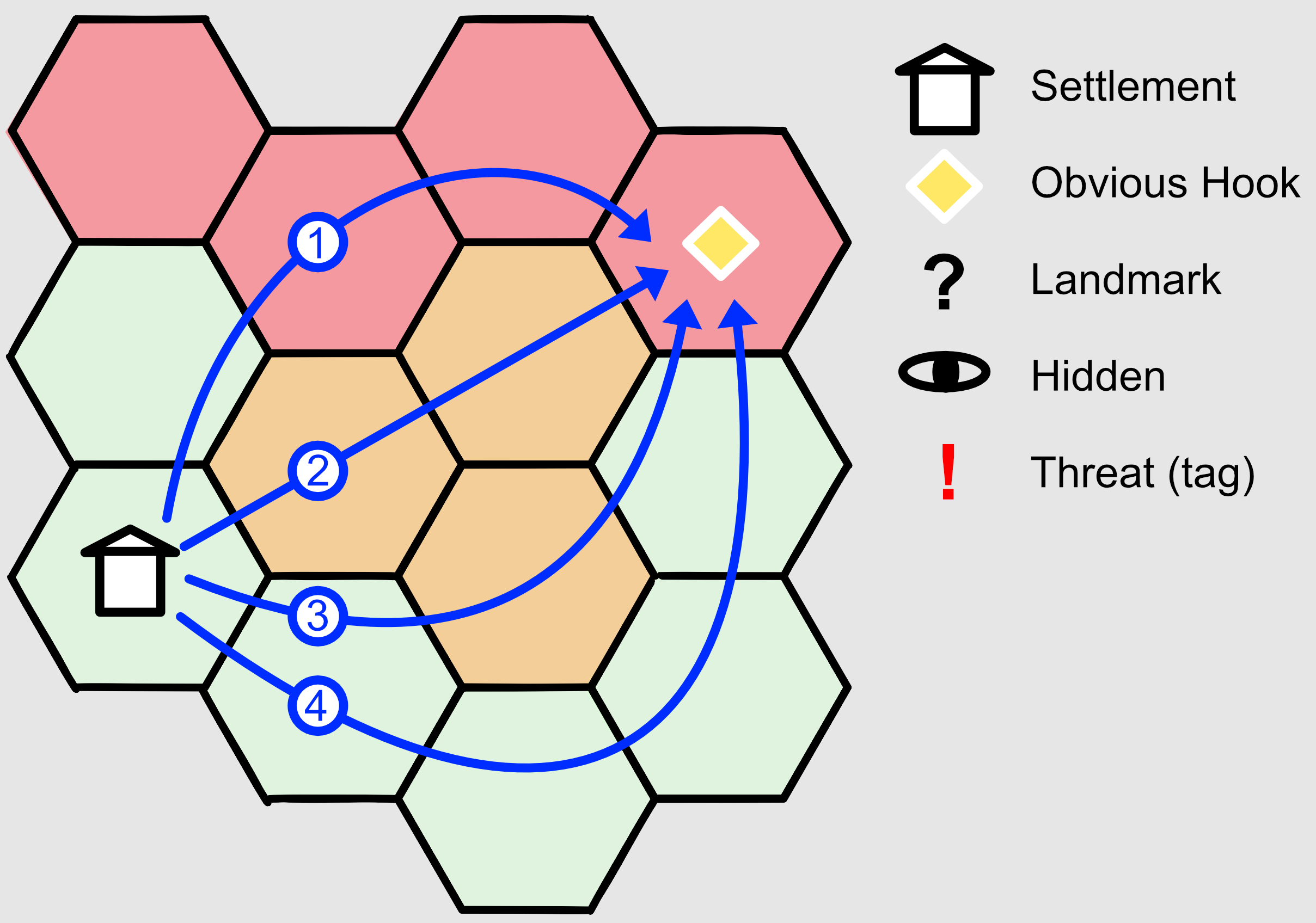 We have four possible ways of reaching our obvious hook from the settlement. Routes 2, 3 and 4 will all take around the same travel time but each carries slightly less risk. Route 1 is much slower. We need to balance these out a little, so we add:
We have four possible ways of reaching our obvious hook from the settlement. Routes 2, 3 and 4 will all take around the same travel time but each carries slightly less risk. Route 1 is much slower. We need to balance these out a little, so we add:
- An additional obvious hook to route 1, to make it more appealing
- Landmarks to routes 2 and 3
- Extra risk to route 4
 This is better, and plus the map is starting to look more populated! But there’s still a little to be done in and around the obvious hook itself.
This is better, and plus the map is starting to look more populated! But there’s still a little to be done in and around the obvious hook itself. - Tagging the hook as a threat makes it more interesting and helps define the fiction in the next step
- Adding some nearby hidden features means more of a sense of discovery as the PCs venture further from the settlement
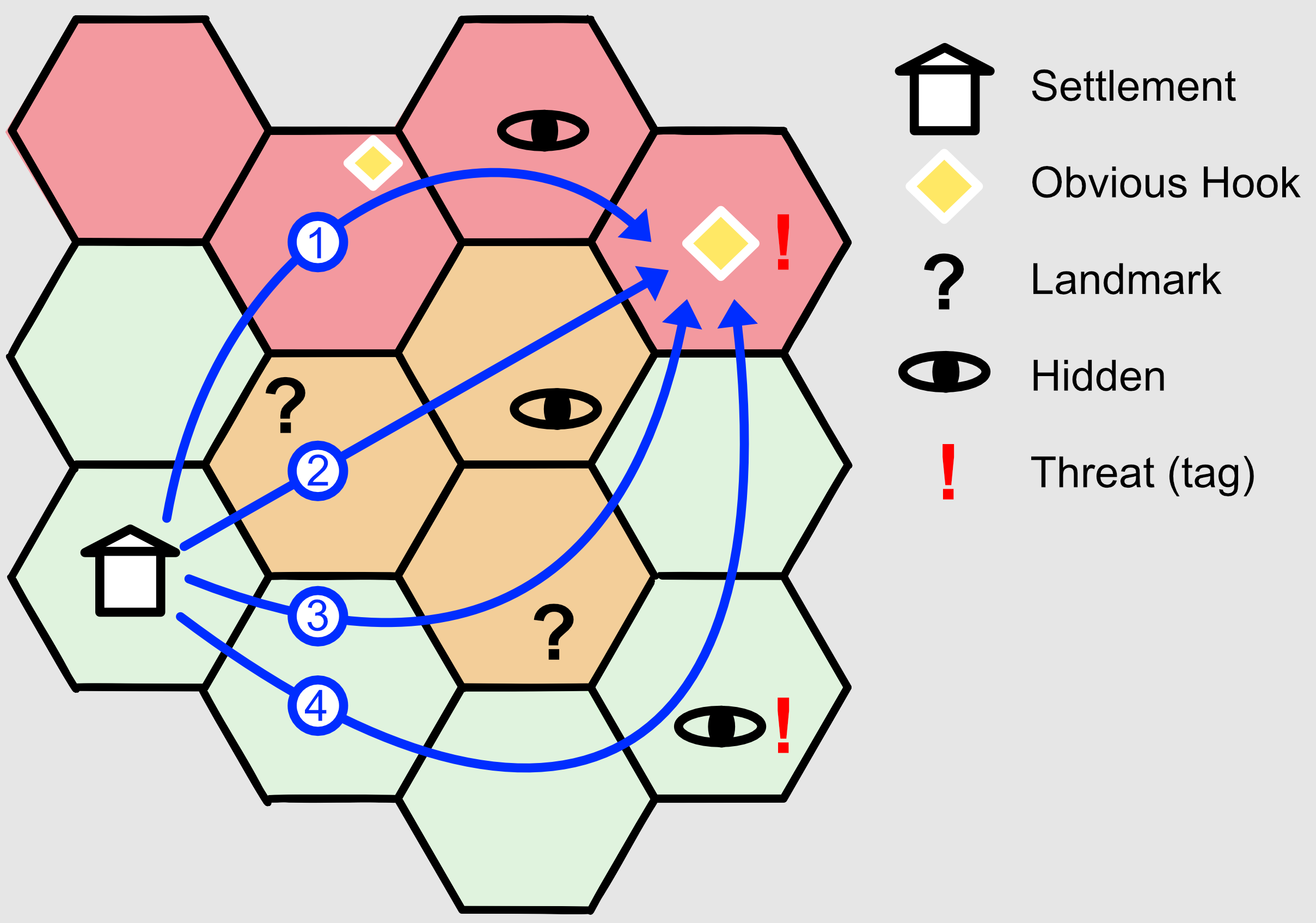 Now we have our mechanical framework, we can generate some fiction to hang on it.
Now we have our mechanical framework, we can generate some fiction to hang on it.
3. Defining the Points of Interest
In my opinion, a hex’s point of interest should provide at least one of the following, and preferably more:
- Loot and treasure to obtain (or some other reward e.g. a boon from a minor diety)
- An interesting choice or dilemma
- Something that is time-dependent
- A notable foe to defeat
- Lore and history about the world
- An obscure secret (see secrets in Landmark, Hidden, Secret)
- Information about another point of interest, rumour or hook
- A puzzle to solve
- An NPC to talk to or otherwise peacefully interact with (e.g. a merchant)
- A reason to return
- An entrance to a dungeon
(Readers will notice some intentional similarities here with Arnold K’s dungeon checklist)
The other important reason for variety within the points of the interest is it allows the GM to gauge what the players are interested in. By offering a menu, you can see their preferences and understand not merely the sort of thing to add as the campaign builds, but also where you should go light and heavy on your prep. For example, if your players are heavily invested in the history, then you can build a timeline of different eras/interactions to discover.
Note that we’re assuming for simplicity’s sake that each hex has one point of interest - I will sometimes have zero (especially close to a settlement, as seen in this example) and sometimes have two (so that players don’t assume they’ve found everything). For an actual campaign I would do this process a few times in various directions from the settlement (and add at least one additional settlement as well).
On Threats
I’ll talk about this more in Part 2, but with respect to tagging certain points of interest as ‘threats’. What this means in general terms is “Something that has the potential to grow in danger, either to the party and/or something they care about”. A threat might get fleshed out into a front, complete with goals and a faction clock… but it might not need to be. My most memorable threat from a previous campaign was simply an unnaturally fast-growing plant that was cutting off a settlement’s water supply the more it grew.
Illustrating the Map
I’m going to go with a very standard combo of grassland, hills and mountains to make it clear how I’ve matched it to the terrrain difficulties above. 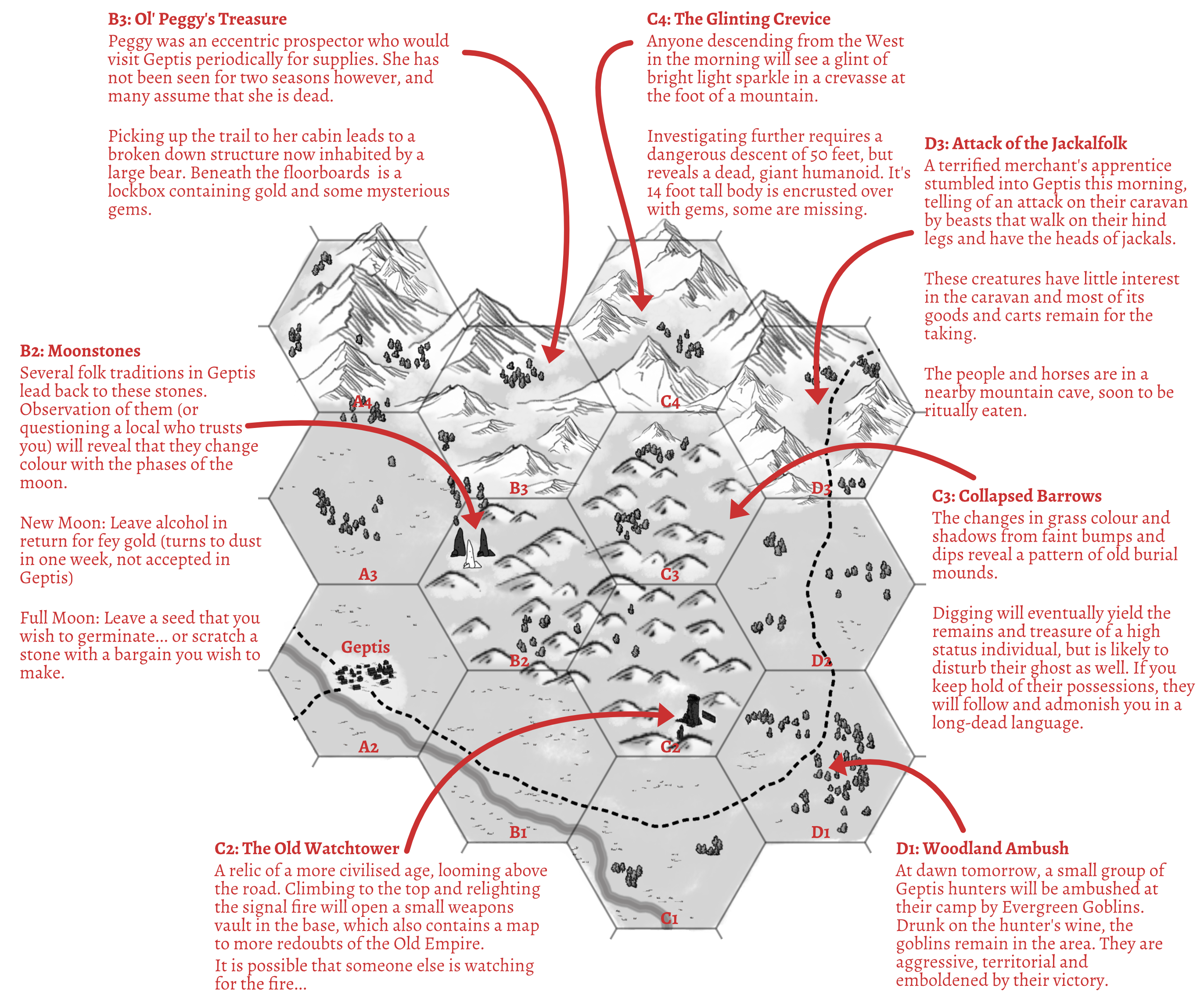 People ask me fairly often how I make these (especially those who are familiar with my C grades in both GCSE Art and Graphic Design). It’s actually fairly simple - I use Wonderdraft with the default assets, taking care to use a limited colour palette (greyscale for an example like this, but I used soft natural colours for this piece). I find taking note of the relative size of mountains/hills/trees/settlements is important. It doesn’t have to be to scale, but should imply that one is bigger than the other.
People ask me fairly often how I make these (especially those who are familiar with my C grades in both GCSE Art and Graphic Design). It’s actually fairly simple - I use Wonderdraft with the default assets, taking care to use a limited colour palette (greyscale for an example like this, but I used soft natural colours for this piece). I find taking note of the relative size of mountains/hills/trees/settlements is important. It doesn’t have to be to scale, but should imply that one is bigger than the other.
Names and hex codes (along with arrows and notes in this example) are then layered over the top using Affinity Designer. You can do the hex grid in Affinity as well if you want (set your grid to triangular) or indeed write labels in Wonderdraft (but Affinity has more power to layer, baseline etc plus a lot more fonts).
Design Notes
D3 is our obvious hook - the PCs can be clearly told that, whilst the captives/dead bodies might have treasure on them, the bulk of the goods and valuables are not of interest to the foes here. It’s all just sitting around for the taking! And since it’s created by the same civilization as the PCs it is easy to appraise its cash value! There are, of course, some further reasons:
Presenting at least some members of the caravan as captured rather than slaughtered creates a moral dilemma, a potential dungeon nearby and the prospect of an additional reward/favour.
There is a classic OSR encumbrance puzzle (How do we get these trade goods back when all the horses are dead? If we bring horses along, will we get attacked ourselves?).
The scared merchant’s apprentice is fun to roleplay with.
The threat here is obvious: If the party don’t defeat the jackalfolk, they will grow bolder and stronger. Making it more of a magical ritual distinguishes it from the goblins in D1.
Jackalfolk (this world’s take on Gnolls) allow for some truly alien motivations (like the classic demon worship) but also lets the players make deductions/assumptions based on real world animal behaviour.
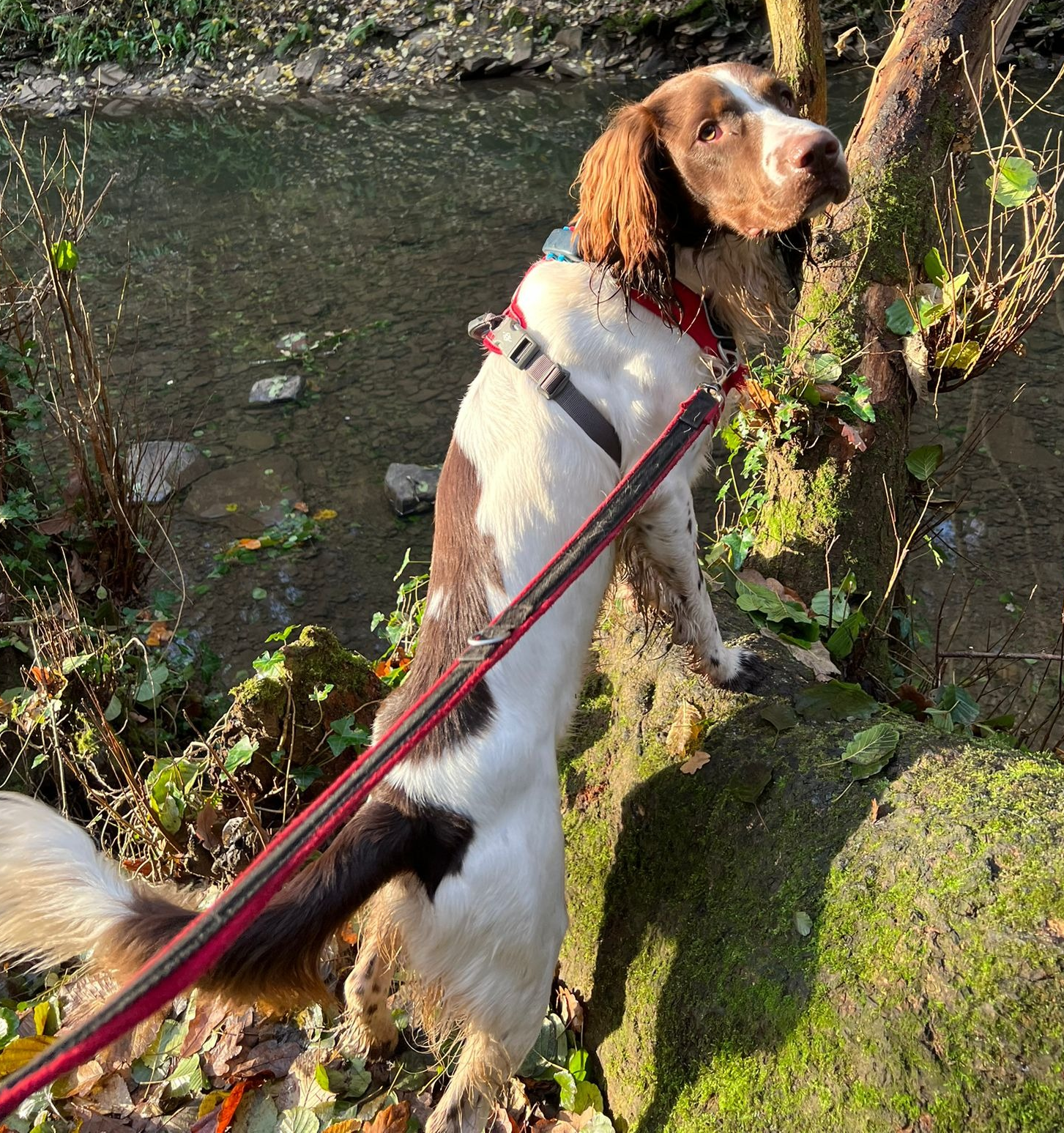 Terrifying bipedal canines
Terrifying bipedal caninesB3 leaves Peggy’s fate ambiguous, so she might not be too happy if she finds out she’s been robbed. It’s also deliberately not too challenging - a party should have lots of options to get past the bear rather than engaging it directly. It’s intended to be an obvious hook, but not as obvious as the caravan above. A more mystery-focused party has plenty of intrigue here along with C4 and B2.
C4 is an attempt to add mystery and treasure but is hazardous and hard to find. A reward for those scouring the mountains or intrigued by the contents of B3.
B2 is deliberately variable with time. It rewards further investigation and repeated visits. Potentially the start of a big scheme by the PCs, especially if they can rope in some allies from Geptis. Equally not worth fleshing out in much more detail yet because they might just write it off as too risky from the start!
C3 was originally going to be something to fight, but I decided that a curse was more entertaining and had more interesting consequences. You could add something here about a creature (either sentient or not) investigating the holes dug by the party.
C2 is the classic ‘that thing on the horizon looks interesting’. Could be the start of a whole plot line or just be used to underline how old and mysterious this land is. Implies a breakdown of law and order relative to the past, which is a thematic link to our obvious hook.
D1 features everyone’s favourite: drunken goblins. Lots of options for information to leak out in advance of them being encountered, since they’re not exactly stealthy. A threat nonetheless, and if I was to expand the map further they would be a whole civilization in a forest further South. Deliberately left ambiguous as to whether they want to rob, ransom, enslave or eat the hunters.
4. What comes next
You will note that we don’t yet have the following:
Names on the map other than the starting settlement
A rumour table
A random encounter table
Weather
Factions or faction clocks
Any drawings of creatures on the map
These will be covered in part 2. That’s mostly because I see them as filling in the gaps between the defined points of interest already established - partly because I don’t want them to contradict anything we’ve already prepped, but mostly because I consider them a key part of the information flow from GM to players.
Until next time!
Minimum Viable Worldbuilding - The Rule of 5
This is a technique for a ‘history-forward’ method of worldbuilding. One where you first construct the history of a location and use that to inform that day-to-day world that your players will encounter. It works for pretty much any size of area, from an individual structure (such as a dungeon) to an entire planet or solar system. I generally use it for towns, villages and any ruin or similar where the party are likely to spend more than a couple of sessions.
The term ‘minimum viable worldbuilding’ refers to the overarching goal behind this. You want to give your players enough material to make a location feel like it has both a past and a present, with multiple threads (and possible interactions between them) to explore. Locations that are entirely ‘past’ feel static - implausible in the way that some unlooted places in open world videogames are. Locations that are entirely ‘present’ feel generic, as there is no context or contrast with whatever the current crisis or rumour is. However, no GM has the time to prepare a fictional history that even comes close to that of the real world, and to do so would fix it too rigidly, incapable of further evolution).
Basically, you’re aiming for somewhere between a Rothko (wherein the absence of detail leads to divergence between what different players project onto it) and a Bosch (time-consuming and leaves you a prisoner of your own detail if you wish to adjust something during play).
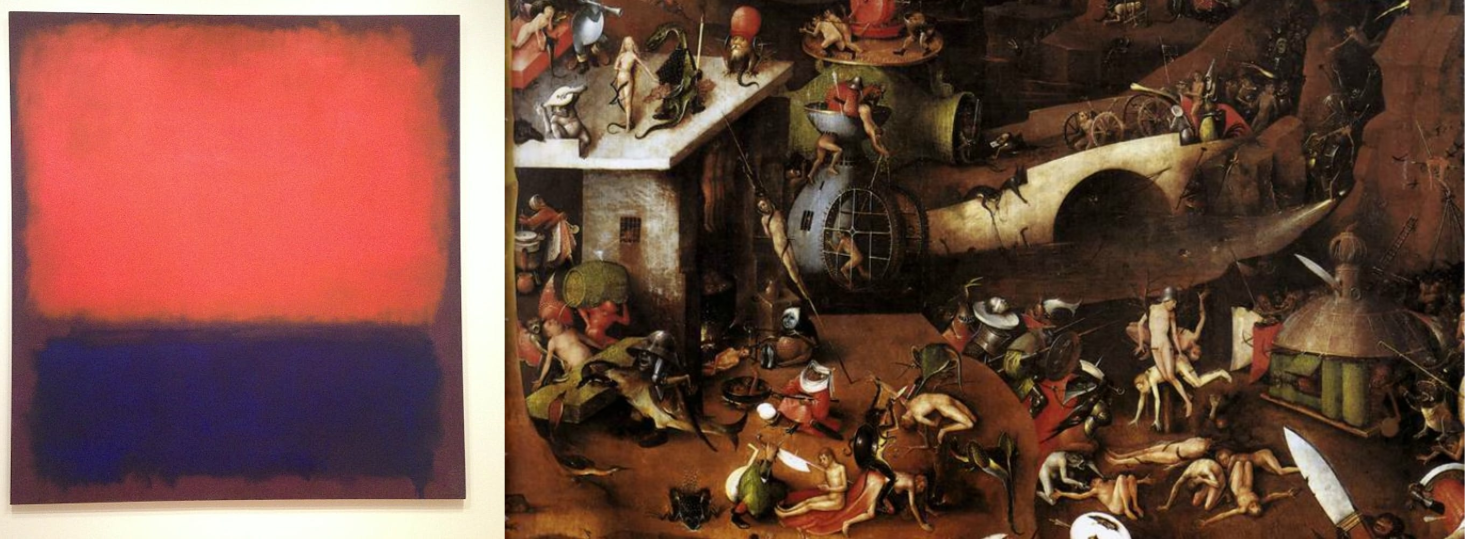 Note that I cannot help but look for Wally (Waldo to the Americans) in Bosch paintings. Look, there he is, getting eaten by a half-beetle, half-sparrow.
Note that I cannot help but look for Wally (Waldo to the Americans) in Bosch paintings. Look, there he is, getting eaten by a half-beetle, half-sparrow.
So what is it?
The basic principle is to answer the question “What happened here five _________ ago?” Where the blank can be any unit of time from seconds to millions of years. We choose five different units of time, thus asking five slightly different questions. From these we creatre a timeline with intervals that get exponentially longer the further back you go. The different units will also impact the nature of answers, and how they are expressed in the world.
Aim for your answers to be unique to that area. For example, if something is an answer for two adjacent towns, then it’s actually an answer to the same list of questions for the region, not an individual town.
You can also add one or more pieces of implied information that player characters would encounter in the present. Some of the examples below have had this added. This then leads onto the following section, in which we derive interactions and situations.
Millions of Years
Geographic features. Key steps or divergences in the evolution of plants and animals. Deposits of geological resources. Creation myths and similar works of great, fundamental magic.
- An asteroid rich in mithril impacted from above, creating Silverwave lake.
- The warm bloods’ thick fur meant they survived The Time of Ice.
- Dinosaurs that died in the thick river mud were fossilised, creating a seam of well-preserved remains.
Millenia
Events described in holy books, philosophical tomes or oral traditions. Extinct civilizations with dead languages. Ruins where the purpose of them and/or their method of construction is unclear.
- The great tablets covered in runes were raised on the clifftop, still undeciphered even now.
- The journey of Salid, Son of Mur, brought back the treasures that were sealed in the Vault of Kings.
- The Karakhim ruled this land as despots, practicing a bloody but even-handed system of justice.
Centuries
Things recalled by longer-lived species. Building of a structure where the architecture and use is still clear today, even if ruined. A notable battle or other victory (legal, magical, political) with wide ramifications.
- Malcolm the Great was victorious, and his lineage still rules to this day.
- The construction of the huge amphitheatre which most of the town now lies within.
- With the translation of the apocrypha complete, a schism developed in the followers of T’Gren.
Decades
Within the living memory of the oldest humans. The establishment of current borders/jurisdiction. A natural disaster that is hoped never to be repeated. The last time a now abandoned structure was used.
- The day of three rainbows, seen as a sign that the land was fertile and blessed.
- An assassin’s blade found the heart of Merther Tywit, recently canonized as Saint Tywit.
- The supposed day of judgement for The Chosen of Datch, which did not come to pass.
Years
Changes of ruler/government. An unsolved crime still lurking in local memories. The war responsible for the ongoing insurgency. A decision or event that is still being argued about by older people.
- Phinneas the mage built their tower one bend along the river.
- A fire tore through the Heartwood. The new saplings are still small and fragile.
- The gates of Murin’s Wall were closed due to the plague, and still are today.
Months
The happenings of the previous season. An ongoing legal dispute. A scandal fresh in local memories.
- Every sow on the Winthrop Farm became pregnant overnight. The piglets are due any day now.
- The East guard tower collapsed. Work has not yet started on a replacement, despite much discussion.
- Lord Northwood imposed punitive taxes, causing much resentment.
Weeks
The most recent news from a distant place (in a pre-telegraph world). The latest crisis for local government.
- The Queen is dead. Long live the King.
- A supply ship foundered on Devil’s Reef. Prices are much higher already.
- The new road to the capitol was completed. The first pilgrims have just arrived.
Days
Gossip and rumour that is the current ‘talk of the town’. Events that are likely unknown to those outside this local area.
- There was a fight at the funeral of old Tim. Black eyes remain visible on the combatants.
- Strangely coloured lights were seen at the windows of the long-empty Gavelack Hall.
- A group ventured into Spiderweb Forest to hunt the Speckled Stag.
Hours
Occurences of the previous day or night. Things that people are still learning about and reacting to.
- Hilary and Benedict have gotten engaged. They are from two rival families.
- Famed bandit leader Karl the Crimson has pitched his camp across the river.
- Ursula the Miller is missing. Her wife swears they went to bed as normal last night.
Minutes
The immediate aftermath is experienced by the player characters. The event could still be ongoing or have people instinctively reacting to it.
- The town hall is ablaze. Smoke and flames are visible.
- An elderly stranger laid his hand upon the plague victim. They are already awake and smiling.
- Loud trumpets signalled the start of Prince Rupert’s procession.
Seconds
Inciting incidents. Things that the player characters can observe directly and react to.
- The actor playing Ser Winthrop staggers backward, covered in blood. That wasn’t a prop knife!
- Lightning slams into the sign at the crossroads, sending fragments everywhere.
- The foreman of the jury pronounces the defendant as guilty while the crowd watches.
Deriving the Current Situation
As an example of putting this into practice, let’s consider the town of Ambridge as an example. We aren’t trying to draw connections at this stage - just throw some interesting and varied answers down on a piece of paper.
“What happened here five centuries ago?”
A group of desperate travellers chanced upon a large, abandoned orchard. Who planted it remains unclear.
“What happened here five decades ago?”
A power struggle as the last of the Hanley family passed away without issue.
“What happened here five years ago?”
The murder of popular blacksmith Earl Connely. It remains unsolved.
“What happened here five weeks ago?”
Reports emerged of merchants being attacked on the West road. The attackers work at night, are humanoid, cover their faces and mostly take valuable cloth or thread.
“What happened here five minutes ago?”
A cryptic symbol appeared on the wall of the Goose & Gander. It is green, luminous and slimy. It resembles an octopus caught in a spiderweb.
We then take these answers and look first at what is immediately obvious - what would the characters notice or be told about as soon as they enter? Then we move onto deeper reasons behind what is happening, and the connections between them. Finally, we ask what is hidden and secret, and what motivations are behind the events that have happened or are unfolding?
As the characters enter the town:
- Everyone is talking about the symbol. People are running over to look at it whilst others back away. The owner of the Goose & Gander has started to wonder how to profit from it.
- The mysterious robbers are less discussed, unless someone invents a rumour that connects them with the symbol.
- Theories fly around as a few brave souls touch the symbol and discussion continues over some glasses of the wine the town is famous for (possibly all the party knew before coming here).
As they learn more and spend more time here:
- The tensions of the earlier power struggle have not entirely vanished. There are still rivalries between the families that have been here the longest and they seldom inter-marry.
- Earl Connely was known for the elaborate carvings he could create in metal. The were often based around the number eight and there are probably still some examples dotted around the place.
- The town’s prosperity rests on the orchard. A belief has developed that its fertility is waning.
And if they themselves investigate:
- A friendly slime spirit has taken pity on Earl’s weak and feeble ghost, and is attempting to lead people to the truth (despite not speaking any languages) - he was killed to prevent his popularity from challenging the current ruling family.
- A secret fertility cult is constructing a cloth effigy to burn as part of a restoration ritual. Certain extreme elements believe there should be a human sacrifice inside, and propose capturing a suitable victim…
- The plan of the orchard matches with a constellation familiar to one of the characters. More evidence that the prophecy is accurate.
But why 5?
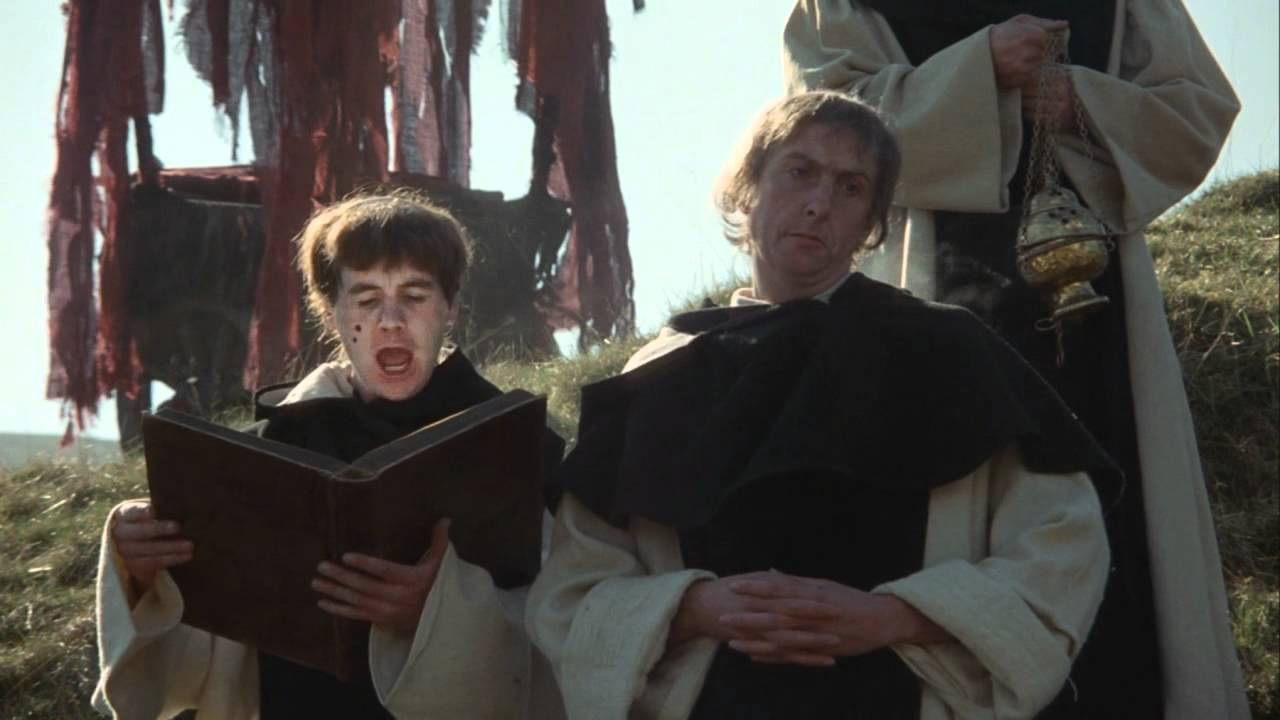 Even in 2022, tabletop RPG blogs are required by law to feature at least one still from this film. I have chosen to get mine out of the way early, but write to your local representative today to spur change.
Even in 2022, tabletop RPG blogs are required by law to feature at least one still from this film. I have chosen to get mine out of the way early, but write to your local representative today to spur change.
Measuring both time increments and the number of questions as the same number makes it easy to remember. Moreover, the rule of three is already a thing, and also three doesn’t feel like quite enough. The idea here is to imply greater depth - by creating just enough material that the details and ramifications of it can’t be summarised in just a single conversation. Five things gives you ten possible interactions between them all - more if you have three or more things all interact simultaneously!